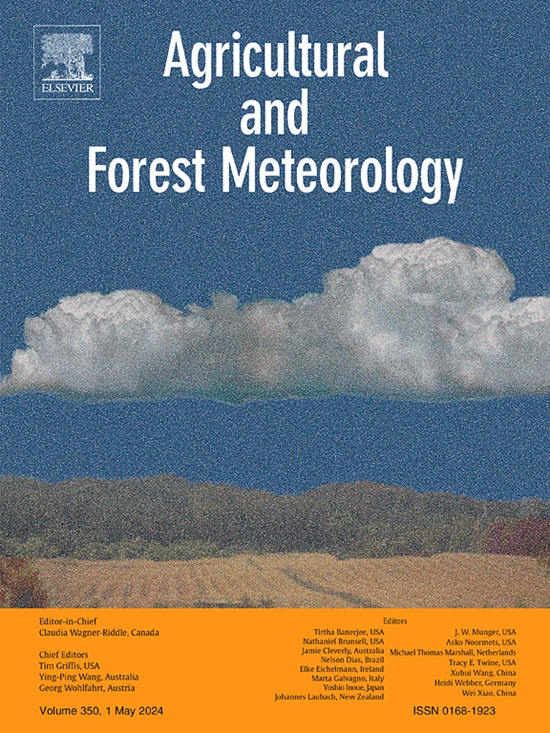在干燥的土地上,土壤蒸发量减少
IF 5.6
1区 农林科学
Q1 AGRONOMY
引用次数: 0
摘要
全球变暖导致的蒸汽压差(VPD)上升增加了全球陆地表面土壤蒸发(E),而全球干燥导致的土壤水分(SM)减少抑制了E。然而,这两个因素对全球E的相对贡献仍然知之甚少,对其长期趋势造成了很大的不确定性。本研究构建了一个将物理过程与机器学习相结合的E模型,并使用来自全球368个通量站点的现场E数据验证了其性能。经过训练的混合模型随后被用于创建历史和未来时期的全球陆地表面E数据集,从而能够识别这些时间框架内E的长期趋势和驱动因素。研究结果表明,1982 ~ 2023年,全球地表E呈-0.28±0.07 mm/年的长期下降趋势,地表E的负面影响大于VPD增加的积极影响。在未来气候变化情景下,预计全球陆地表面E将以比历史时期观测到的更快的速度继续下降(2024 - 2100年3个气候变化情景下平均为-0.42±0.11 mm/年²),其中SM在这一趋势中起主导作用。另外9组E数据进一步证实了长期下降趋势。这些结果强调了全球干旱在推动全球气温持续下降方面的关键作用,并强调了气候变化如何加剧了全球水资源面临的风险。本文章由计算机程序翻译,如有差异,请以英文原文为准。
Declining soil evaporation on a drying earth
Rising vapor pressure deficit (VPD) due to warming has increased global land surface soil evaporation (E), whereas reduced soil moisture (SM) from global drying has suppressed E. However, the relative contributions of these two factors to global E remain poorly understood, creating significant uncertainty regarding its long-term trends. This study constructed an E model that integrated physical processes with machine learning and validated its performance using in-situ E data from 368 global flux sites. The trained hybrid model was then employed to create a dataset of global land surface E for both historical and future periods, enabling the identification of long-term trends and drivers of E across these timeframes. Our findings revealed that the negative impact of SM decline on global E outweighed the positive effects of increased VPD, resulting in a long-term downward trend in global land surface E from 1982 to 2023 (–0.28 ± 0.07 mm/year²). Under future climate change scenarios, global land surface E was projected to continue its decline at a faster rate than observed in historical periods (average –0.42 ± 0.11 mm/year² under three climate change scenarios from 2024 to 2100), with SM playing a dominant role in this trend. The long-term downward trend was further corroborated by nine additional E datasets. These results underscored the critical role of global drying in driving the persistent decline in global E and highlighted how climate change was exacerbating risks to global water resources.
求助全文
通过发布文献求助,成功后即可免费获取论文全文。
去求助
来源期刊
CiteScore
10.30
自引率
9.70%
发文量
415
审稿时长
69 days
期刊介绍:
Agricultural and Forest Meteorology is an international journal for the publication of original articles and reviews on the inter-relationship between meteorology, agriculture, forestry, and natural ecosystems. Emphasis is on basic and applied scientific research relevant to practical problems in the field of plant and soil sciences, ecology and biogeochemistry as affected by weather as well as climate variability and change. Theoretical models should be tested against experimental data. Articles must appeal to an international audience. Special issues devoted to single topics are also published.
Typical topics include canopy micrometeorology (e.g. canopy radiation transfer, turbulence near the ground, evapotranspiration, energy balance, fluxes of trace gases), micrometeorological instrumentation (e.g., sensors for trace gases, flux measurement instruments, radiation measurement techniques), aerobiology (e.g. the dispersion of pollen, spores, insects and pesticides), biometeorology (e.g. the effect of weather and climate on plant distribution, crop yield, water-use efficiency, and plant phenology), forest-fire/weather interactions, and feedbacks from vegetation to weather and the climate system.

 求助内容:
求助内容: 应助结果提醒方式:
应助结果提醒方式:


